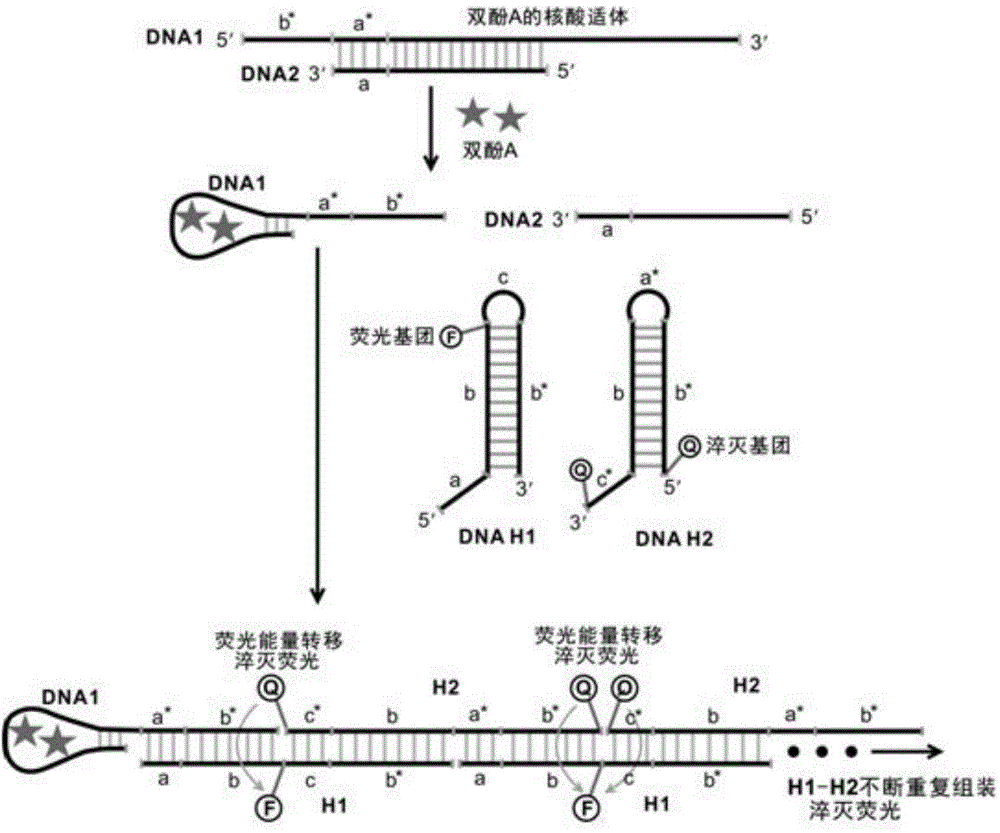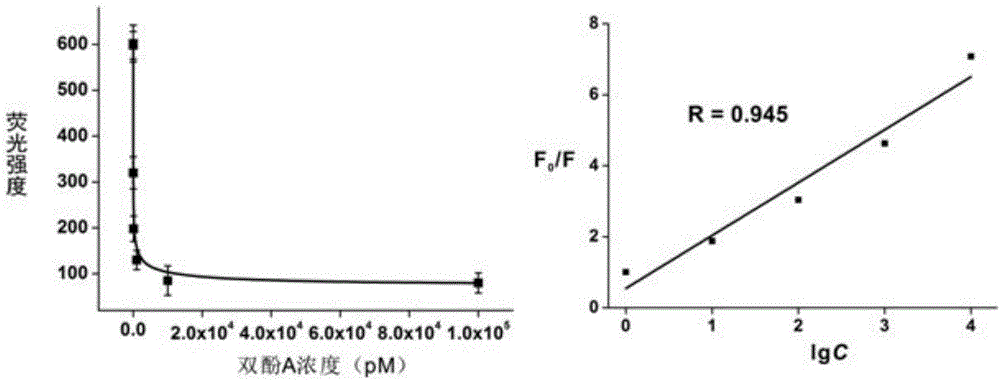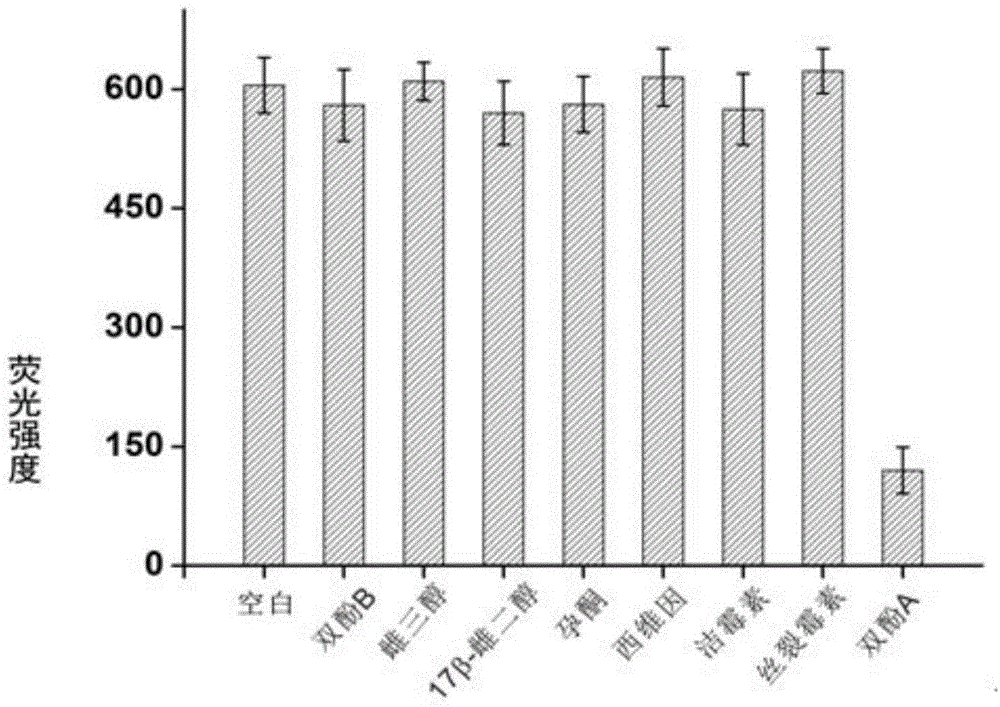Bisphenol A detecting method and detecting kit based on dual-quenching-group nucleic acid self-assembling technology
A detection kit and self-assembly technology, which is applied in the field of environmental analytical chemistry, can solve the problems of low sensitivity, time-consuming and labor-consuming, high detection cost, etc., and achieve the effects of improving detection sensitivity, reducing fluorescent background, and good selectivity
- Summary
- Abstract
- Description
- Claims
- Application Information
AI Technical Summary
Problems solved by technology
Method used
Image
Examples
Embodiment 1
[0042] A bisphenol A detection kit based on double quencher nucleic acid self-assembly technology, comprising the following components:
[0043] (1) DNA1, the 5' end or 3' end of the nucleic acid aptamer of bisphenol A is extended to form DNA1, which includes b* region, a* region and bisphenol A nucleic acid aptamer region, the sequence is as follows:
[0044] Nucleic acid aptamer of b*a*bisphenol A
[0045] 5'-AGTCTAGGATTCGGCGTG--GGTTAA--CCGGTGGGTGGTCAGGTGGGATAGCGTTCCGCGTATGGCCCAGCGCATCACGGGTTCGCACCA-3' (SEQ ID NO. 1);
[0046] (2) DNA2, DNA2 is complementary to the a* region of DNA1 and part of the bisphenol A nucleic acid aptamer region, the sequence is as follows:
[0047] a
[0048] 5'-CTGACCACCCCACCGG--TTAACC-3' (SEQ ID NO.2);
[0049] (3) DNA H1, the 24th base at the 5' end T-modifies the fluorescent group FAM, the sequence is as follows:
[0050] a b c b*
[0051] 5'-TTAACC--CACGCCGAATCCTAGACT--CAAAGT--AGTCTAGGATTCGGCGTG-3' (SEQ ID NO. 3);
[0052] It includes a,...
Embodiment 2
[0063] A method for detecting bisphenol A based on double quencher nucleic acid self-assembly technology, comprising the steps of:
[0064] (1) All DNAs were dissolved in 20 mM Tric-HCl buffer, and 100 nM DNA1 and 400 nM DNA2 were hybridized in Tric-HCl buffer for 20 minutes to form a DNA1-DNA2 complex;
[0065] (2) Add the sample to be tested to the DNA1-DNA2 complex and react at room temperature for 45 minutes;
[0066] (3) Add 1mM DNA H1 and 1mM DNA H2, react at room temperature for 60 minutes, then record the fluorescence intensity of the system, the excitation light is 490nm, the emission peak is 530nm, calculate the bisphenol A in the sample to be tested according to the established standard curve concentration.
Embodiment 3
[0068] Detection of different concentrations of bisphenol A:
[0069] Prepare bisphenol A standard solutions with concentrations of 1pM, 10pM, 100pM, 1nM, 10nM and 100nM, respectively, and store them at room temperature.
[0070] Add bisphenol A solutions of different concentrations to the reaction system described in Example 1 respectively, and detect the fluorescence intensity after sufficient reaction, as shown in figure 2 As shown, as the concentration of bisphenol A increases, the fluorescence intensity decreases, and when the concentration of bisphenol A exceeds 10 nM, it gradually reaches saturation. Taking the logarithm of bisphenol A concentration (lgC) as the abscissa, the fluorescence intensity ratio (F 0 / F) is the ordinate, draw the standard curve, the two have a good linear relationship, the linear range is from 1pM to 10nM, the linear equation is: F 0 / F=1.49lgC+0.54 (R=0.945), (F 0 : initial fluorescence intensity; F: fluorescence intensity corresponding to...
PUM
| Property | Measurement | Unit |
|---|---|---|
| emission peak | aaaaa | aaaaa |
Abstract
Description
Claims
Application Information
 Login to View More
Login to View More - R&D
- Intellectual Property
- Life Sciences
- Materials
- Tech Scout
- Unparalleled Data Quality
- Higher Quality Content
- 60% Fewer Hallucinations
Browse by: Latest US Patents, China's latest patents, Technical Efficacy Thesaurus, Application Domain, Technology Topic, Popular Technical Reports.
© 2025 PatSnap. All rights reserved.Legal|Privacy policy|Modern Slavery Act Transparency Statement|Sitemap|About US| Contact US: help@patsnap.com



